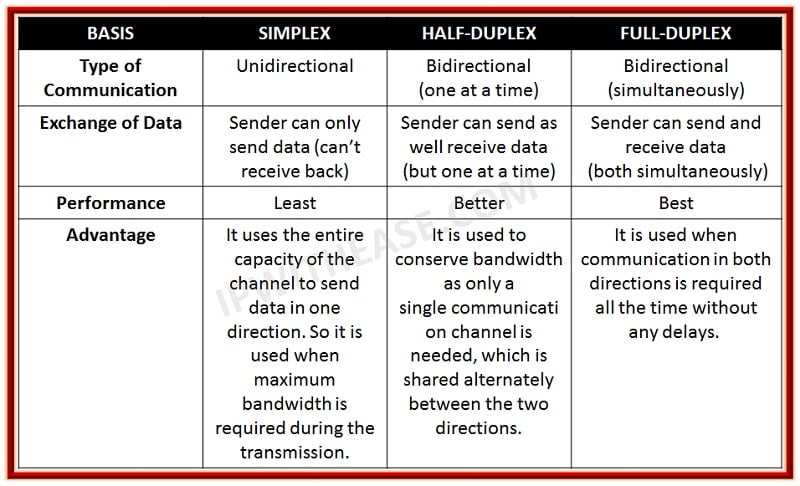Explain Difference Between Half Duplex and Full Duplex Transmission
Like a walkie-talkie you can send or receive but not both at once. The main difference between simplex half duplex and a full duplex transmission mode.

Comparison Of Simplex Half Duplex And Full Duplex Network Interview
On the other hand in the full-duplex mode of transmission the.

. Full Duplex is the mode of transmission in which again there is bi-directional flow of data ie Sender can send as well as receive the data at the same time. The term duplex on its own refers to the capability to send and receive data. The Difference Between Half and Full Duplex Explained.
If the channels are physical and not logical transmission uses separate wires for transmission and reception. Full-duplex on the other hand enables two-way traffic at the same time. Disadvantage of Half-Duplex mode.
Show less Show more. A half-duplex transmission could be considered a one-way street between sender and receiver. In half-duplex transmission both the devices can transmit and receive data but not simultaneously.
The primary difference between the three modes of transmission is that in a simplex mode of transmission the communication is unidirectional or one-way. A full-duplex device is capable of bi-directional network data transmissions at the same time. Half-duplex devices can only transmit in one direction at one time.
Full Duplex Transmission. In Communication Networks Communication can take place in one direction Data. Half Duplex Transmission Mode.
In simplex mode only one device can transmit the signal. What is the difference between half duplex and full duplex transmission mode. In the full-duplex mode both the connected devices can send as well as receive data at the same time.
Modern network interface cards are configured for full-duplex support by default. Duplex simply means youre able to send and receive data most often the human voice from the same device whether that be with your phone 2-way radio or PC. Whereas in the half-duplex mode of transmission the communication is two-directional but the channel is interchangeably used by both of the connected devices.
In half-duplex mode when one device is sending the data then another has to wait this causes the delay in sending the data at the right time. There are three ways or modes of data transmission. In a full-duplex connection information flows in both directions at the same time like a telephone conversation.
In a half duplex HDX system communication flows in one direction at a time. Full duplex communicates in both directions at the same time. In Windows you can set up duplex settings in the Properties window of your network.
In half-duplex mode the signal can be transmitted in both directions but one at a time. In half-duplex mode both devices able to transmit the signal but not at the same time. However for all links connected to a LAN hub the half-duplex mode should be used in order to prevent a duplex mismatch that could decrease network performance.
In half-duplex mode both the devices can send and receive the data and also can utilize the entire bandwidth of the communication channel during the transmission of data. A communications channel can be used to communicate one way at a time or in both directions at once. For all links between hosts and switches or between switches the full-duplex mode should be used.
Subsequently one may also ask what does does it mean for a pipe for be half duplex or full duplex. The term Transmission Mode defines the direction of the flow of information between two communication devices ie. The switch sends information to the endpoint device and vice versa.
Half duplex Mode is the mode of transmission in which there is bi-directional flow of data but one at a time ie Sender can send as well as receive the data but does one task at a time. Each of the channels is half-duplex but together it makes full-duplex. Full duplex FDX switches allow for the simultaneous transmission of information between the switch and the endpoint.
Half-duplex allows communication in both directions but not at the same time. It tells the direction of signal flow between the two devices. In simplex mode only one device can send the signal.
When one device is transmitting the other device can only receive. In full duplex mode the signal is sent in both directions at the same time. For example lets say two files need to be exchanged.
Simplex Half duplex HDX Full duplex FDX. An example is a telephone. An example is a walkie-talkie.
Click to see full answer. While In full-duplex mode the signal is sent in both directions at the same time. The use of full-duple increases data transmission rate.
With half-duplex mode data can move in two directions but not at the same time. 8 rows Simplex Transmission Mode. Half duplex communicates in one direction at a time.
A half-duplex connection allows information to flow in only one direction at a time. Half duplex allows transmitting and receiving but not at the same timeFull duplex allows transmitting and receiving at the same time. In half duplex mode both devices can transmit the signal but one at.
If one side is half-duplex and the other side if full-duplex then when the half-duplex side is transmitting and the full duplex-side is also transmitting the half-duplex side having internally looped transmit to receive with see something other.
Defining Simplex Half Duplex And Duplex

Half Duplex Vs Full Duplex Vs Simplex Transmission Mode

Difference Between Half Duplex Transmission Modes And Full Duplex Transmission Modes Geeksforgeeks

What Is Simplex Half Duplex And Full Duplex Mode Of Communication Tooabstractive
Comments
Post a Comment